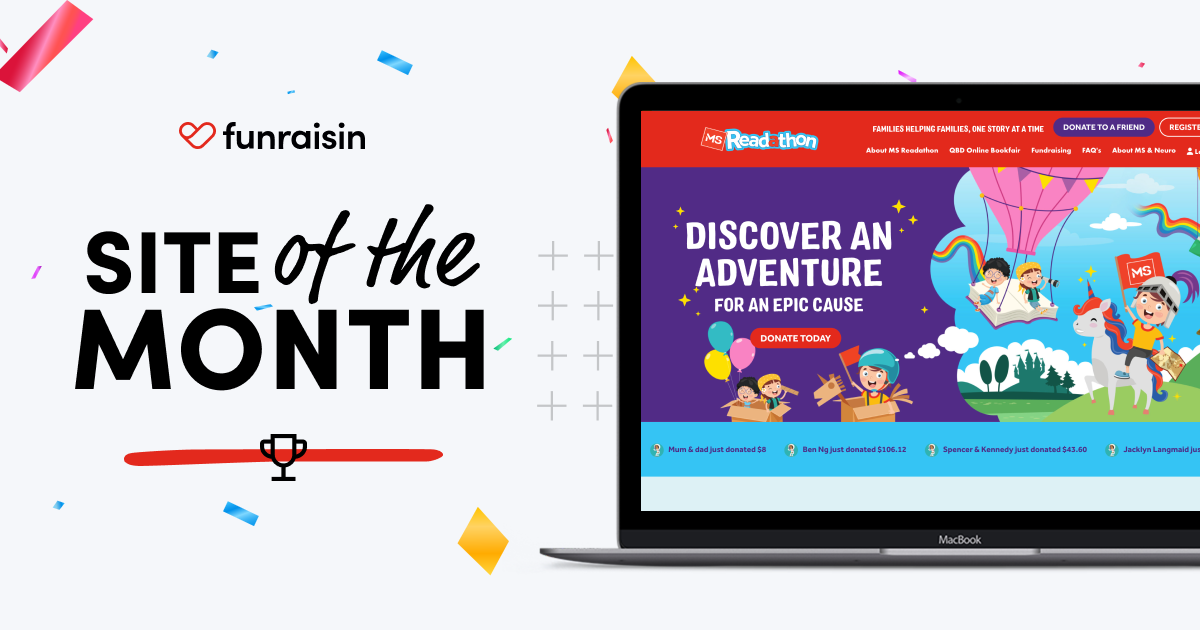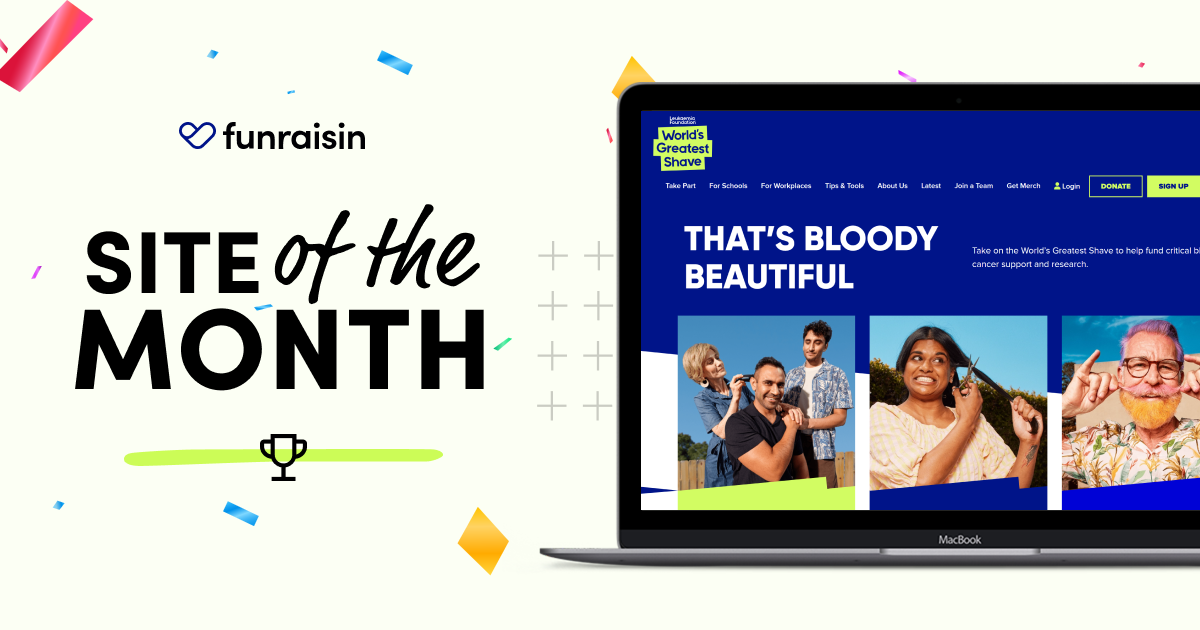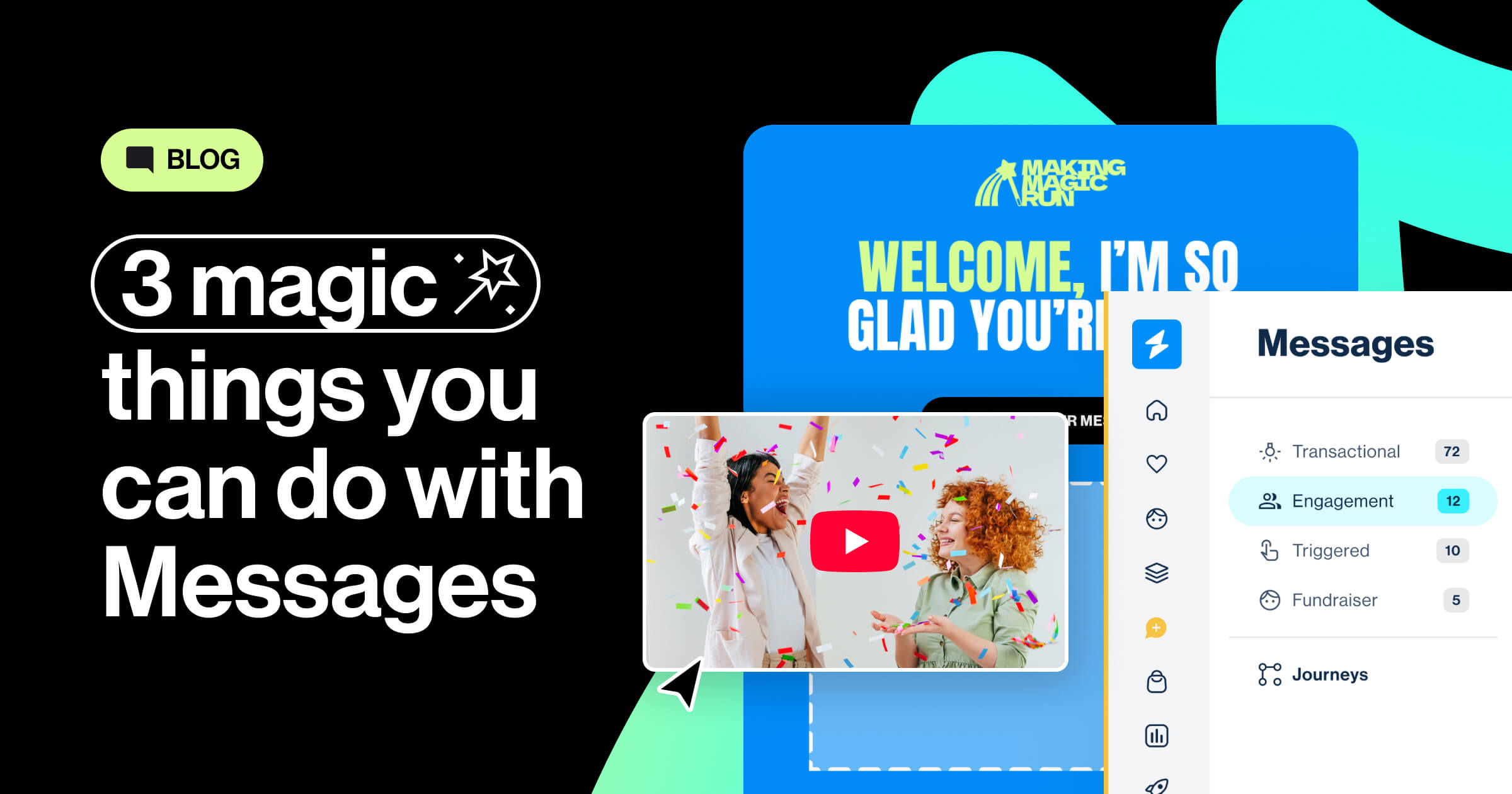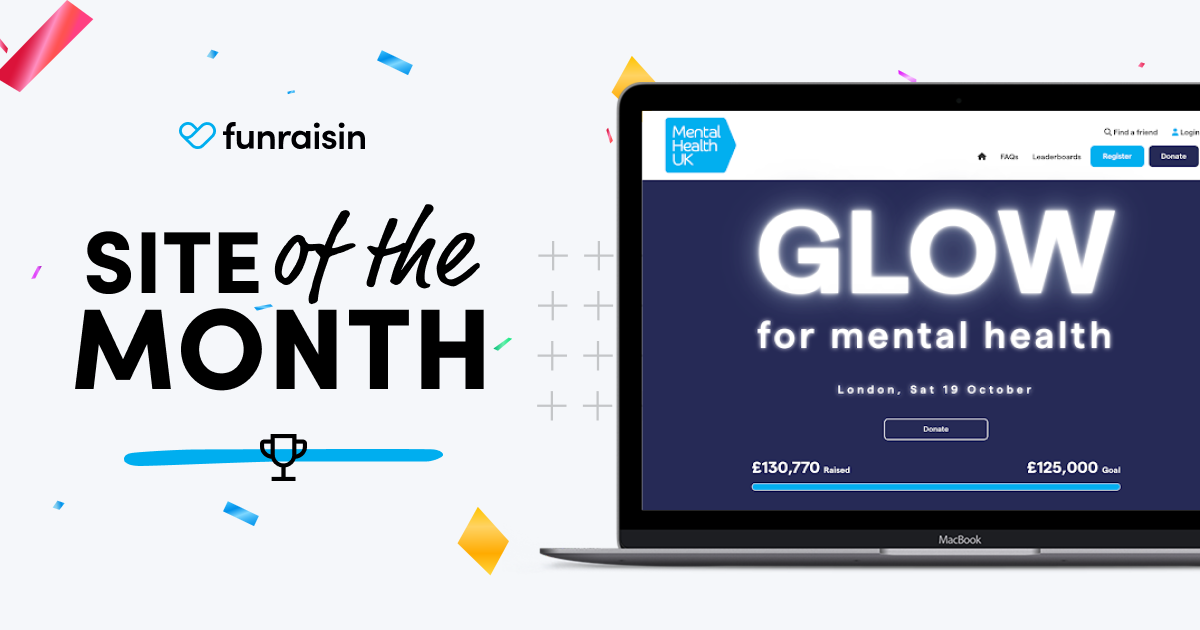
Imogene Grant
Head of Marketing at Funraisin
Over the past 15 years, I’ve worked within seven major nonprofits, ranging from global humanitarian organisations to local children’s hospital foundations, with a particular passion for digital and peer-to-peer fundraising.
In my role with Funraisin, I have a bird’s-eye view of what NFPs are doing around the globe: where their imaginations are heading, where their ambitions lie, and how technology is driving them forward.
Fundraising trends may come and go, but there’s always something exciting about peering into the future.
So, with no crystal ball but plenty of inspiration, here are my top 10 predictions for where ambitious charities will venture in 2025!

1. E-commerce meets giving
Charities are experimenting with how donors interact with their causes, and I’m here for it. Picture this: instead of simply clicking “donate,” supporters "shop" for items directly tied to mission-related needs. An environmental charity, for example, might invite donors to add eucalyptus trees for koala habitats, coral fragments to rebuild reefs, or native plants to restore forests to their virtual cart. These seemingly small purchases combine to create a personalised, tangible contribution—far more compelling than a generic donation handle on a form.
While virtual gifts aren’t new, transforming them into a streamlined and interactive online shopping experience elevates the concept entirely. Imagine donors filling their carts with multiple micro-donations that represent real-world impact, culminating in a meaningful contribution that feels personal and intentional. For example, charities could create virtual grocery stores, allowing donors to buy a trolley full of pet food for an animal shelter or essential ingredients for a community kitchen providing meals to people experiencing homelessness.
And this approach isn’t just about novelty—it’s smart. If a donor selects ocean-related items, for instance, the charity can tailor future campaigns to align with their interests, such as marine conservation. The result? A win-win: donors enjoy a more engaging and interactive giving experience, while charities foster deeper connections and build long-term engagement.

2. Small, local, and timely appeals
Economic pressures are real—for donors and for charities. I expect to see more charities leaning into smaller, more frequent appeals that focus on immediate, targeted needs. Think fundraising for emergency housing during a homelessness surge ahead of the winter months or post-Christmas food stores for animal shelters inundated after the holidays. These campaigns thrive on urgency and community spirit, breaking away from the traditional, formulaic appeal cadence.
Here’s what’s really interesting: these campaigns will rely heavily on PR and social media to rally communities. It’s not about cannibalising the stalwart direct mail or telemarketing base; it’s about creating a fast, agile connection between the donor and the pressing need they’re helping to solve. The real challenge—and opportunity—will be in retaining these donors. However, with a lean digital-first approach, there’s real potential for attractive efficiency gains and significant learnings on how to convert one-time givers into loyal supporters.

3. Raffles to drive audience growth
Raffles are making a big comeback—and they’ve gone fully digital. Multimillion dollar businesses (see: Motorculture) have been built around raffling coveted motor vehicle prizes, using clever modern-day membership models to drive growth. These businesses thrive on a sharp digital acquisition strategy, upselling recurring raffle entries and VIP bundles to foster loyalty. Inspired by this approach, charities are now embracing acquisition-focused raffles, offering aspirational, high-value prizes to attract fresh audiences. With the right digital tools, running a raffle has never been easier—no more telemarketing or sellers stationed at shopping malls with a shiny sports car.
Here’s where I see even more promise: strategic brand partnerships. I expect to see more charities teaming up with brands that provide in-kind prizes and co-market the raffle. It’s a win-win: charities expand their reach, while brands gain valuable exposure and align with meaningful causes. Together, they amplify impact, breaking through with a more emotional proposition to straight-up brand promotions.

4. Add-on engagement in appeals
Early in my fundraising career, I met someone who was a die-hard peer-to-peer fundraiser. And a very successful one at that. He said to me, "Why would I ask you to give $100 when you could raise me $1,000?" That perspective stuck with me and continues to shape how I think about fundraising. In 2025, I predict charities will explore add-on engagement opportunities that give donors more ways to support via their planned appeal cycles.
Picture this: a donor completes their donation to your appeal and is then prompted to share an automatically generated personalised supporter page with their networks, inviting friends and family to add to their gift. A tally displays their collective ripple effect—their growing giving impact. This could be especially compelling if the donor has a personal connection or strong conviction about the cause. Peer-to-peer options like this let supporters rally their own networks around the mission, multiplying their impact in meaningful ways.
In my experience, individual giving and peer-to-peer fundraising often operate as distinct approaches within NFP’s, but I see significant potential for greater integration. By testing secondary asks while supporters are already motivated and engaged, charities could unlock new growth and provide more ways for committed donors to amplify their impact. The key will be embedding these opportunities seamlessly into the donation flow, keeping the process intuitive and effortless for donors.
It’s all about layering these elements to build more dimensional campaigns. When donors feel like they’re part of a movement—not just completing a transaction—it transforms the experience. That shift, I believe, would be a game-changer for expanding the reach and impact of campaigns.

5. Journalism-style content
I’m no media expert, but disinformation isn’t going anywhere. In 2025, I predict charities will have an unprecedented opportunity to really step up as trusted sources of news and information. I see a shift toward more journalism-style content that goes beyond traditional brand-level social posts to tackle topical and even controversial issues head-on. If I were running comms for a NFP tackling big, often politicised issues, I’d be hiring a curious, bold journalist with a knack for social media to bring that approach to life. I’ve met these people—they’re out there, and they’re brilliant at cutting through the noise to tell compelling, authentic stories that resonate.
Gated content channels will be key in this space—think subscriber-only newsletters, exclusive social groups, or microsites that deliver accurate, in-depth reporting. By genuinely being thought leaders, charities can build deeper trust and engage their communities in more meaningful conversations. I know I’m hungry for better, more substantive content from brands I trust.
Platforms like Medium could play a valuable role here, helping charities reach new audiences where valuable, original thought-piece content is gold. With the right approach, this shift toward thoughtful, journalist-inspired storytelling could redefine how charities engage in a world dominated by noise and misinformation.

6. Regular giving 2.0
Regular giving has long been the backbone of nonprofit fundraising, but younger generations are engaging with causes in ways that differ significantly from traditional supporters. I predict a shift toward dynamic, subscription-style models that not only sustain ongoing support but also provide tangible, engaging benefits to donors. It’s about evolving regular giving into something more experiential and interactive.
Imagine this: donors who commit to monthly contributions receive exclusive digital perks like a chapter of an endangered species guide that unfolds over the year, complete with immersive stories, photos, and videos. Or physical rewards, such as collectible cards, badges, or patches that tie directly to the cause—think a patch representing every conservation milestone or achievement their support has enabled. Kids would love it.
The key here is personalisation and storytelling. Donors aren’t just giving; they’re part of an ongoing journey, tracking their impact and feeling recognised for their contributions. By turning regular giving into an experience that feels purposeful and rewarding, charities can appeal to a generation accustomed to subscription boxes and gamified experiences, this could be the future of donor retention—turning passive giving into an active, rewarding connection with the cause.

7. The TikTok takeover continues
No surprises here: TikTok and other video-first platforms will continue to dominate, pulling audiences away from the likes of Facebook, and charities need to follow suit. This means investing in short, authentic videos that tell compelling, human stories. If your organisation isn’t on TikTok yet, now’s the time to create your profile. I’d be hiring someone who’s savvy with a smartphone, doesn’t shy away from the camera, and knows how to capture raw, real moments that resonate. Forget perfection—focus on authenticity and start getting content out there.
One of the best things about TikTok is that you don’t need to grind away at building a massive following to see results. A single piece of great content has the power to go viral on its own, opening your message up to new and untapped audiences. The key is to start experimenting and learning on the fly. Dive in, iterate, and let the platform’s unique style guide your creativity—it’s where your audience is, and it’s where your stories need to be told.

8. It’s time to double down on UX
With so much budget allocated to acquisition, the real return on investment happens on the landing page. And while this is nothing new, it’s worth repeating: if reviewing and improving your UX isn’t already on your roadmap, it needs to be. Optimising donation forms for speed and simplicity, designing mobile-first experiences, and integrating features like e-wallet payments, pre-populated PURLs, and one-click donations are no longer optional—they’re essential. The goal? Make donating effortless. When every click matters, a seamless user experience can mean the difference between a lost opportunity and a lifelong supporter.
But it’s not just about driving strong conversion rates; it’s also about optimising the average gift amount. Striking this balance requires a well-thought-out donor journey that encourages generosity while remaining intuitive and frustration-free.
Charities should also be looking at their web analytics to identify top-performing landing pages and testing click funnels to refine and improve the donor experience. Are people dropping off midway through the process? Are calls to action compelling? Every data point offers a chance to tweak and elevate performance.
At Funraisin, we obsess over getting this balance right. We continually test, learn, and templatise the best donation experiences and registration flows to help charities maximise both conversion rates and average gift amounts. If you need guidance, check out TOGL—our (free!) Testing and Optimisation Growth Lab. We work with our charity clients to experiment, learn, and make data-driven improvements to drive growth and maximise ROI.

9. “Super Teams” in P2P campaigns
Peer-to-peer campaigns are evolving, and I predict charities will start to embrace what I’m calling “super teams.” Imagine this: during registration, participants choose their adventure by joining a team led by a specific ambassador or coach. This ambassador—a personal trainer, a person impacted by the cause, or even a well known influencer—becomes the face of their journey, regularly appearing on the P2P dashboard with customized content like workouts, training plans, recipes, or motivational messages. It’s as simple as splitting the registration flow, but it unlocks the potential for rich, curated experiences tailored to different supporter interests.
The impact? Participants don’t just engage with a faceless brand—they build a connection with a human guide who keeps them motivated and inspired throughout the campaign. This approach creates deeper engagement, extends the campaign’s lifespan, and encourages repeat participation. Supporters return year after year, drawn to new ambassadors and fresh journeys that continue to surprise and delight.
I’ve been in love with this idea ever since I discovered Sweat With Pride, which nails this concept with vibrant drag personas as ‘perspirational trainers’. A true slay.

10. Collaboration as a superpower
Finally, I predict—or perhaps hope—that we’ll see more nonprofits teaming up around shared goals, embracing a co-op approach to appeals. Imagine a homelessness charity partnering with a mental health organisation to address the interconnected challenges of housing instability and mental health struggles. These kinds of collaborations are more than just practical—by adopting a co-op model, charities can pool resources, audiences, and expertise, creating multi-dimensional campaigns with broader appeal and deeper impact. It’s not just about efficiency and reach; it’s about showing donors a united front in addressing systemic challenges. This collaborative spirit sends a powerful message in today’s fractured world—one of solidarity, shared purpose, and collective action.
Better together is an approach I’d love to see take root in 2025.
So there you have it—my predictions for where ambitious charities will be making their mark in 2025.
It’s an exciting and transformative time to be in this space, with endless opportunities to innovate, connect, and inspire. Whether it’s rethinking regular giving to create more dynamic experiences, transforming peer-to-peer campaigns into personalized journeys, or adopting bold new acquisition strategies, the future of fundraising is full of potential.
Those willing to carve out resources for experimentation will lead the way.
I can’t wait to see where we go next!
Let’s make your big ideas happen!
Whether you’re exploring new ways to engage supporters or ready to optimise your campaigns, Funraisin can help. Fill out the form below, and let’s chat about how we can power your ambitions for the year ahead. From innovative features to tailored solutions, we’re here to make 2025 your best fundraising year yet!








